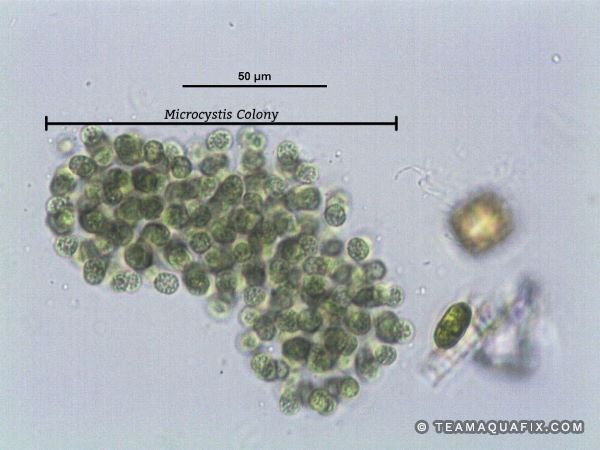
Microcystis can cause high effluent TSS and generate dangerous toxins within both the lagoon and effluent.
If Microcystis growth is suspected, taking precautions such as wearing a mask and gloves to avoid skin contact is recommended.
Algaecides can be effective in controlling Microcystis but are not typically recommended due to the possible release of toxins from the dead cells. Reducing the nutrient build-up and internal release of soluble nitrogen and phosphorus is a recommended way to limit the growth of this cyanobacteria. Sludge can be physically removed by dredging or a non-disruptive option: Sludge Rx. This can aid in organic sludge reduction and prevent the resuspension of nutrients.
Microcystis is a phosphorus-favoring planktonic cyanobacterium that forms gelatinous colonies in wastewater lagoons. In most wastewater lagoon systems, blooms of Microcystis would indicate either a very high buildup of organic sludge or overloading with particulate BOD. Microcystis can form bright green scum but generally only in calm waters. In ponds with vigorous mixing Microcystis is unable to form surface scum and is unlikely to be present in high levels. The cells are spherical and can be green, or black, depending on the presence of gas vesicles. These vesicles help to keep the colonies close to the surface of a pond for optimal light and gas exchange. Microcystis forms colonies of small clusters that are able to rapidly disperse and reproduce, taking over a pond. These clusters then duplicate, resulting in massive amounts of new colonies. The cells are somewhat tolerant of low light and anaerobic conditions and therefore they can begin growing in the sludge. Microcystis can produce cyanotoxins, like microcystin, that are dangerous to humans and animals.

39041 RGE RD 283,
Red Deer County, AB T4E 0M2
Phone: 1-888-466-0031 |
Fax: 1-888-507-9716
To place an order, please fill out the required fields below and proceed to checkout. Ensure all information is accurate, and feel free to contact our support team if you have any questions or need assistance. Thank you for choosing us!